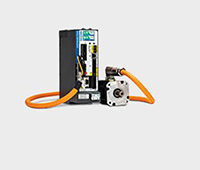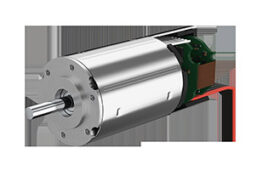
The Servotronix design team uses the HDC adaptive non-linear control algorithm for the CDHD series of servo controllers.
A drawback of this configuration is an intrinsic tracking error during movement proportional to the speed. Feed-forward methods tend to reduce this error, but at the expense of an overshoot or a longer settling time.
To overcome these limitations, Servotronix Motion Control developed an adaptive non-linear control algorithm. Named HD Control (HDC), this algorithm uses a parallel configuration, in which all branches are on the same level and executed in each sampling period. On each branch, a variable gain parameter is introduced and automatically optimized for high gain and stability, minimizing position error and settling time.
The algorithm consists of a variable gain module, which contributes to a low tracking error, and an adaptive feed-forward module, which allows a short settling time.
The variable gains (VGd, VGp, VGiv, VGi) are calculated internally and modified dynamically during operation by the HDC algorithm. Each gain is a specific function of the system variables, such as velocity and position error. During movement, the variable gains may reach values up to ten times higher than at stop. This produces highly accurate path-following during movement, together with quiet low-speed operation and standstill. System stiffness is more than tripled during movement, resulting in low tracking error.
The four variable gains are balanced by a proprietary algorithm that maintains the stability of the system. The Kd (derivative) parameter branch is comparable to the velocity feedback loop, and serves to reduce velocity error. The Kp parameter branch is a proportional position feedback loop, for reducing position error. The Ki parameter branch is an integral of the position feedback loop, reducing standstill error.

This image shows a simplified diagram of HD Control.
The Kiv parameter branch is unique to HDC and combines the effects of the Kp and Ki branches. It produces a stiffness more than double that of Kp, without creating oscillations. It reduces the tracking error during both acceleration and standstill. It also eliminates standstill error, as does Ki, but with the rapid response time of Kp.
The adaptive feed-forward module helps achieve a short settling time. During movement, the correspondence between acceleration and motor torque is monitored, and this relation is used during the deceleration phase to process the integral term. At the end of movement, the adaptive feed-forward algorithm modifies the content of the integral term according to the expected path acceleration, resulting in a zero settling time.
HDC is integrated in the Servotronix CDHD servo drive series. Tuning is performed automatically by the CDHD interface software, ServoStudio. While autotuning is usually sufficient, certain applications may require manual fine tuning for the optimization of control parameters.
Automatic and manual tuning is based on the same principle. During autotuning, the quality of the movement is measured and evaluated by the drive and the software. During manual tuning, the quality of movement is evaluated by the user. In either method, the servo control parameters are modified progressively and the value that achieves the best performance is selected.
HDC tuning is simple and is performed much like conventional PID tuning. Each variable gain is increased progressively until some oscillation occurs, then reduced about 10 to 20% to a safe value.
For instance, one gantry robotic application required a sustained accuracy of 2 to 3 µm at maximum speed. Using the CDHD servo drive with the HDC algorithm, the maximum application speed was increased from 120 to 160 mm/sec while maintaining the required accuracy, and resulted in a 33% increase in machine throughput.
HDC can be advantageous in applications requiring path tracking and low settling time, such as CNC and cutting, conveyor tracking, pick-and-place operations, PCB mounting and welding, as well as painting, coating and gluing.
Servotronix Motion Control
servotronix.com
Filed Under: ENGINEERING SOFTWARE, Drives (servo) + amplifiers, MOTION CONTROL, Motors • servo





Tell Us What You Think!